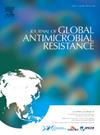中国新疆耐碳青霉烯类肠杆菌的流行和新型 ST11-KL30 耐碳青霉烯类肺炎克雷伯菌的出现。
IF 3.7
3区 医学
Q2 INFECTIOUS DISEASES
引用次数: 0
摘要
研究目的针对中国新疆耐碳青霉烯类肠杆菌(CREs)患病率研究不足的问题,阐明耐碳青霉烯类肺炎克雷伯菌(CRKP)ST11-KL30的基因组特征:方法:从 2021 年至 2023 年在新疆收集 CRE。通过琼脂稀释法进行碳青霉烯类抗菌药物药敏试验。在Illumina平台上完成了全基因组测序,并对CRKP进行了测序分型、K-locus和O-locus鉴定、毒力评分评估和系统进化分析等后续基因组分析。在体外和体内测定了 CRKP 分离物的毒力,并通过水晶紫染色评估了生物膜的形成。此外,还重建了毒力质粒,并根据公共数据库中的基因组数据揭示了 CRKP ST11-KL30 的形成:结果:共收集到 85 株 CRE 分离物,其中 CRKP 最常见(68/85)。KPC 是 CRKP 中最主要的碳青霉烯酶(60/68),而 NDM 型碳青霉烯酶在其他物种中更为普遍。ST11 是 CRKP 的优势克隆,在系统发育上分为三个群:ST11-KL64、ST11-KL47 和 ST11-KL30。CRKP ST11-KL30是一种新型重组克隆,带有类似pK2044的毒力质粒,可通过从ST29-KL30中获取∼57 kb区域而从ST11-KL64衍生而来。与 ST11-KL47 和 ST11-KL64 相比,ST11-KL30 的毒力较低,但生物膜形成能力较强:我们描述了南疆地区 CRE 的流行情况,并报告了一种地区特异性克隆的出现。结论:我们描述了南疆地区 CRE 的流行情况,并报告了一种地区特异性克隆的出现。我们的发现强调了 ST11-KL30 的潜在传播性,因此需要在未来加强监测。本文章由计算机程序翻译,如有差异,请以英文原文为准。
The prevalence of carbapenem-resistant Enterobacterales and the emergence of novel ST11-KL30 carbapenem-resistant Klebsiella pneumoniae in Xinjiang, China
Objectives
To address the lack of research on the prevalence of carbapenem-resistant Enterobacterales (CREs) in Xinjiang, China, and elucidate the genomic characteristics of carbapenem-resistant Klebsiella pneumoniae (CRKP) ST11-KL30.
Methods
CREs were collected in Xinjiang from 2021 to 2023. The antimicrobial susceptibility testing of carbapenems was performed via agar dilution method. Whole-genome sequencing was completed on the Illumina platform, and subsequent genomic analyses of CRKP, such as sequencing typing, K-locus and O-locus identification, virulence score assessment, and phylogenetic analysis, were performed. The virulence of CRKP isolates was determined in vitro and in vivo, and biofilm formation was assessed by crystal violet staining. Additionally, the virulence plasmid was reconstructed, and the formation of CRKP ST11-KL30 was revealed based on genome data from public database.
Results
Eighty-five CRE isolates were collected, among which CRKP was most prevalent (68/85). KPC was the most dominant carbapenemase (60/68) in CRKP, while NDM-type carbapenemase was more prevalent in other species. ST11 was the dominant CRKP clone and was phylogenetically divided into three clusters: ST11-KL64, ST11-KL47 and ST11-KL30. CRKP ST11-KL30 is a novel recombinant clone that harbours a pK2044-like virulence plasmid and can be derived from ST11-KL64 by obtaining an ∼57 kb region from ST29-KL30. Compared to ST11-KL47 and ST11-KL64, ST11-KL30 had lower virulence, but had enhanced biofilm formation.
Conclusions
We describe the prevalence of CRE prevalence southern Xinjiang and report the emergence of a region-specific clone. Our findings underscore the potential dissemination of ST11-KL30, which warrants increased monitoring in the future.
求助全文
通过发布文献求助,成功后即可免费获取论文全文。
去求助
来源期刊

Journal of global antimicrobial resistance
INFECTIOUS DISEASES-PHARMACOLOGY & PHARMACY
CiteScore
8.70
自引率
2.20%
发文量
285
审稿时长
34 weeks
期刊介绍:
The Journal of Global Antimicrobial Resistance (JGAR) is a quarterly online journal run by an international Editorial Board that focuses on the global spread of antibiotic-resistant microbes.
JGAR is a dedicated journal for all professionals working in research, health care, the environment and animal infection control, aiming to track the resistance threat worldwide and provides a single voice devoted to antimicrobial resistance (AMR).
Featuring peer-reviewed and up to date research articles, reviews, short notes and hot topics JGAR covers the key topics related to antibacterial, antiviral, antifungal and antiparasitic resistance.
 求助内容:
求助内容: 应助结果提醒方式:
应助结果提醒方式:


